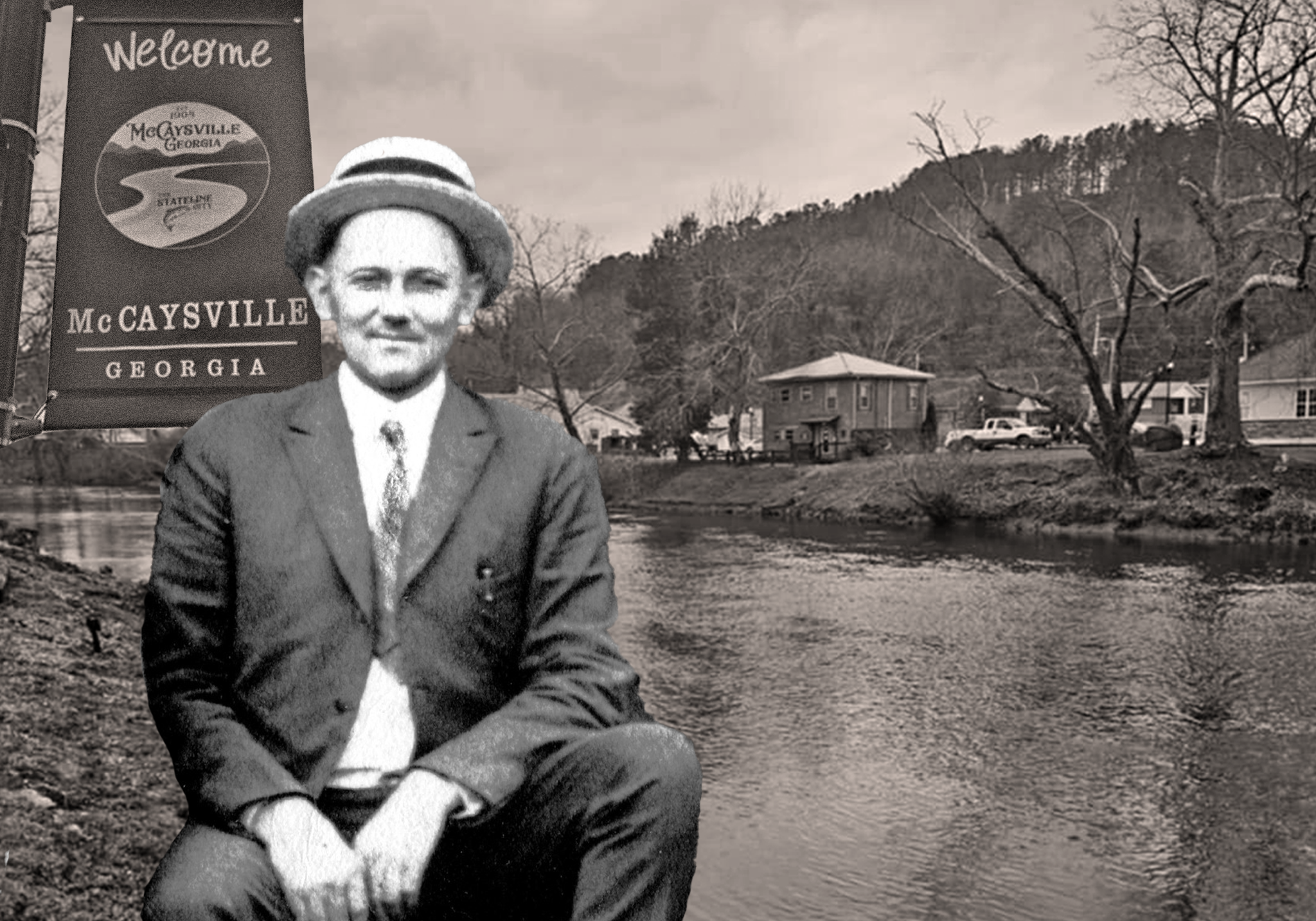The town of McCaysville, which is as gloomy and dark as the interior of a charcoal burner, is without sunlight today. As I pass a filthy, raging river, its waters roiling from constant rain, a gloomy tint permeates the scenery beneath the ominous awning of a cloudy sky.
An unsettling shiver runs down my spine and won’t go away until I’m four miles north of Blue Ridge on Highway 76. But it’s not the Faulkner-esque architecture that draws me to McCaysville; rather, it’s Dr. Thomas Hicks, not for surgery, but to understand and take in the spirit of the town and the location where a man is accused of stealing and selling up to 200 babies in secret.
I drove passed a desolate pizza place as I approached the town, hardly paying attention to its name because I was focused on getting where I was going. However, I pulled into a petrol station to look up information online after seeing that there was no dedicated marker or recognition of the scandal that has had a significant impact on the lives of so many people in the town and beyond. The fact that I had entered a dead zone did not surprise me.The Georgia town of McCaysville is traversed by the Toccoa River. The Cute North Georgian Magazine took the picture.
I finally made the decision to go into the convenience shop and ask the cashier. She surprised me by announcing that her father was one of Hicks’ purported babies before I could complete my question. She showed me his grave site with much enthusiasm and told me the location of his old clinic, which is now a pizza place on Toccoa Avenue.
A vain man s gravesite
I made the decision to go to the burial first, and I set out on a route that took me across a flimsy metal bridge, first following a river path that meandered before veering across the heavily forested slopes. Signs of economic suffering were evident along the road, and the city’s demographic data, which showed a median family income of only $30,078.00, further highlighted this fact.
The density of the trees and the tangible sense of hopelessness coming from houses so run-down that they seemed condemned grew as cold as the chill in my spine. Children played on broken trampolines amid trash-strewn lawns, a harsh reminder of the elusive concept of livable and the sacrifices people must make in order to exist.
However, there were areas of beauty that appeared in the midst of the emptiness. The region’s typical red clay and rough grey rock contrasted with verdant fields painted in pastel tones of green. Maples burned in blazing reds, and the landscape was dotted with clusters of daffodils, delicate sprays of common violets, and bright flashes of yellow wildflowers. All of this was framed by the magnificent Blue Ridge Mountains in the distance.
The cemetery where Dr. Thomas Hicks was buried in a flamboyant and elaborate mausoleum, however, was more beautiful than any scenery. In the peaceful and lovely surroundings, his final resting place was a dark stain that loomed like a horrible apparition. The door’s hefty chain and padlock are noteworthy; they evoke visions of a spectral Jacob Marley.
According to the gas station clerk, the chain was created by people who mistakenly believed it to be real, broke in, and tried to take the birth certificates that were said to be concealed inside. In Taken at Birth’s season 1 episode 2, Dr. Hicks’ adopted granddaughter started the process of exhuming her father’s body in an attempt to learn the truth about her parentage. But except from the documents encoded in his DNA, there was no other record in it. However, the program claimed that the DNA was adequate to answer a lot of the self-identifying Hicks Babies’ questions. There are still some who think that birth records are kept in the shadowy vault, notwithstanding this broadcast disclosure.
I hovered above Dr. Hicks’ tomb, examining the sturdy, smooth walls and the glass behind the doors. I thought about the individual who demanded a mausoleum in the middle of a garden full of simple headstones. In that lonely, haunting hill, in that lonely, haunting city, it was the only thing that could compete with the peaceful mountain view. For a man who ruled hundreds of people’s lives and futures at his discretion, plastic Walmart flowers were not enough. The chilly, ambient twilight environment of this weird border town surrounded me as I stood in this large area. It was raining steadily when I got to my car, zipping my coat.Georgia’s McCaysville is home to the Toccoa River. The Cute North Georgian Magazine took the picture.
Standing in the back alley
The rain had finally stopped by the time I returned to McCaysville’s city boundaries, and there was a sense of peace. While parking close to the downtown bridge, I observed a nearby police officer. Though there was no incoming traffic, I hesitated, considering the possibility of jaywalking. I decided to be safe and follow the traffic laws, so I headed for the bridge that over the swollen, winding Toccoa River.
The spring showers that are common in the area at this time of year have caused the river’s water level to climb significantly. I leaned over the bridge’s edge and looked down at the murky, dark waters. I had a flash of interest and pondered what was behind the surface. I couldn’t help but wonder if someone was observing me back as I stared into the swirling water.
After a few seconds of reflection, the rain’s steady reappearance accelerated my further research. As I hurried downtown, I walked past a window with a religious and political statement that the store owner was most concerned about. Then I noticed a window display with gaudy and hideous Easter bunnies, which would give kids nightmares yet appear to be the pride of old southern women everywhere.The location where Dr. Thomas Hicks used to be is now Kenny’s Pizza & Subs. The Cute North Georgian Magazine took the picture.
I stopped to take a picture of the Easter bunnies’ evil leers before moving on to the structure that used to be the Hicks Clinic. It was a modest, even anticlimactic, edifice. Just a little, little concrete building. However, more than 200 newborns were sold illegally within this dilapidated, unrecognized enterprise.
In fact, some kids were taken from mothers who were told falsely that their children had died at delivery, according to the horrific practice that is described in the documentary Taken from delivery. Furthermore, there are reliable claims that early delivery was induced in order to maximize Dr. Hicks’ supply of infants for adoption by willing parents as well as to lessen his obligation to the mothers he housed in hotels.
As I glanced at this unremarkable building, I understood that its unremarkable appearance shouldn’t have astonished me. Dr. Hicks began his practice by covertly advertising illegal abortions on benches and in phone booths. The need for prudence and concealment was as strong in McCaysville, a thriving railroad and steamboat town, as the influx of newcomers. Drifters, gamblers, and traveling salespeople would gather in the town for the night and then go with the sunrise. McCaysville had its share of women, taverns, and establishments that catered to their demands, much like any other railway town. Dr. Hicks catered to the requirements of the city’s tavern proprietors and prostitutes.Kenny’s Pizza & Subs now occupies the back alley where so many lives were changed. The Cute North Georgian Magazine took the picture.
But his abortion profits were just $100 a procedure, which was a significant sum during the 1950s and 1964. However, Dr. Hicks changed his focus to planning adoptions on the black market after realizing the possibility of higher income. With a kid who was usually much under the expected birth weight, adoptive parents would arrive through the front door with nothing and exit through the rear. Up to $1,000 was sold for a live baby, which was a significant amount in any given year. According to Taken at Birth’s disclosures, birth mothers were not listed on the certificates and, if they were aware of the transaction at all, were only paid $20 for their difficulties. This implied that they were essentially cut off from all chance of ever getting back in touch with their kids again for the price of a new dress. This likely felt like a win-win situation to the doctor.
I walk to the back alley and stop by the door where innumerable lives were cruelly ended and irrevocably changed. Many of the infants linked to Hicks were known to be underweight and thought to be preterm. Premature babies frequently require extended hospitalizations in the Neonatal Intensive Care Unit (NICU) in today’s medical environment. However, within hours or days after their birth, these infants were quickly moved from the doctor to their adoptive parents. It begs the question of how adoptive parents might seek medical care for their child in the event of a medical emergency if there was no documentation of their birth. The sobering fact that several burials might line the remote Blue Ridge Mountains’ roadways, all to feed one man’s ravenous avarice and conceit, is something I’m thinking about. Imagining the lives lost and the families split apart for the sake of filling his own coffers and decorating the walls of his ornate mausoleum makes me shudder.McCaysville, Georgia’s downtown, which is adjacent to Copperhill, Tennessee. The Cute North Georgian Magazine took the picture.
Remembering what others tried to forget
My thoughts are filled with gloomy consideration as I return to my car, particularly because I am a mother of a child myself. I can’t help but think of the desolate, freezing town and the surrounding area that had so many unwanted kids to sell, and the desperate poverty of the women who felt forced to give up their babies for a $20 note and a hotel room. I feel a sense of dread and sorrow as a result of this disturbing understanding. The gloomy atmosphere is further enhanced by the suffocating dampness of the mist that clings to my yellow rain gear, heightening the horror of the secrets that lie within this town. I can’t get rid of the uneasy feeling that the ground beneath this town remembers what people have tried to forget as I drive away.
The publisher of The Cute North Georgian magazine is Carly McCurry. NowHabersham.com, in collaboration with Now Network News, features her work.

 by
by 

